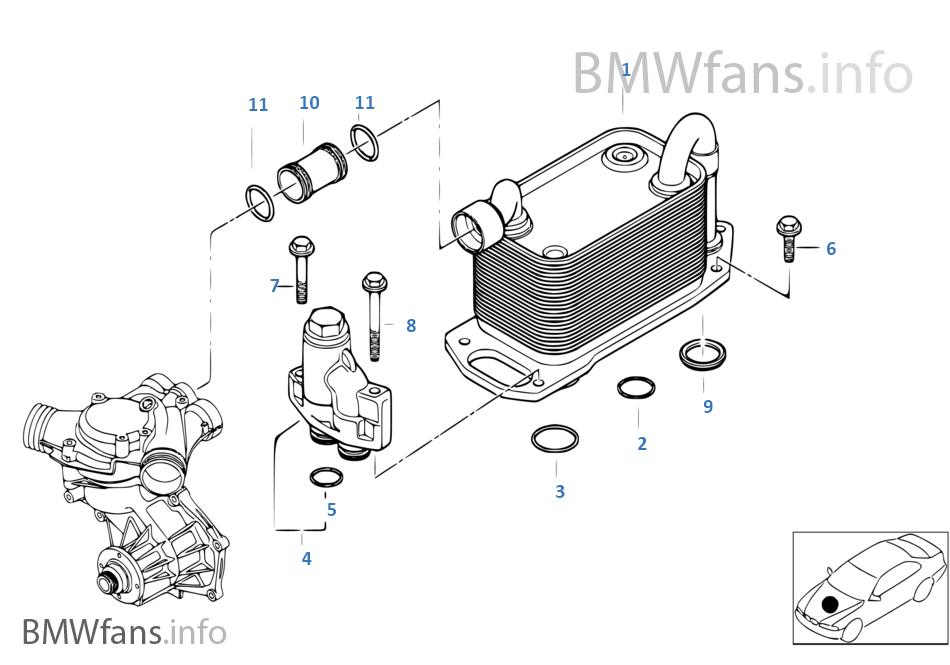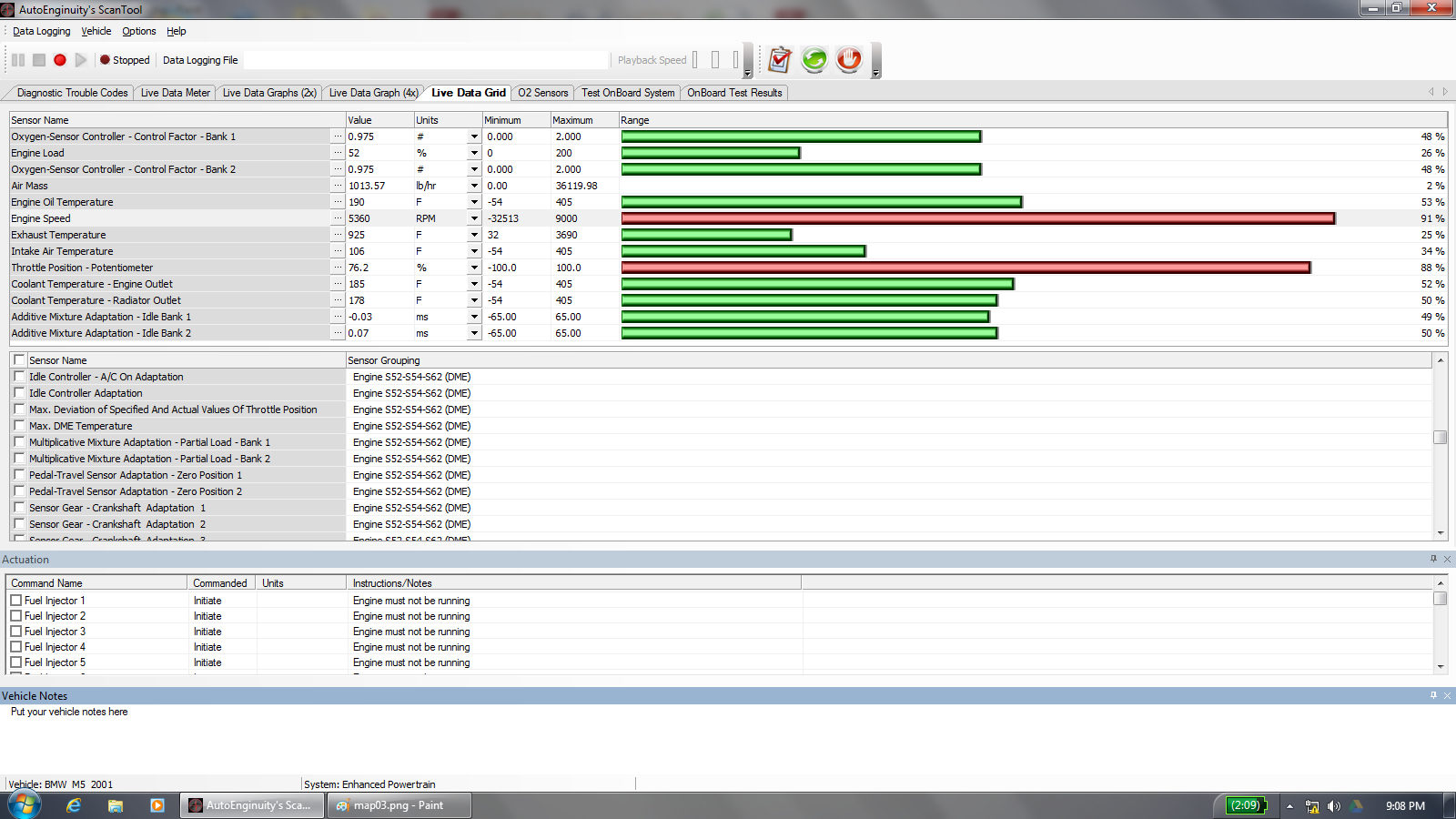Dear All,
Please find below the results of the latest and the previous (Mobil 1 Peak Life 5W-50, BMW E39 540iA, 22081 km) oil analyses for my BMW.
During this oil change interval I again used 100 % E85 fuel with a modified ECU mapping. Unfortunately, I missed to change the oil prior to maximum usage of 20000 km.
There are some values that are worrying me though:
For the current oil change interval I will definitly not exceed 15000 to 20000 km.
What are your opinions?
Philipp
Code:
REPORT #4:
Subject : Mobil 1 Peak Life 5W-50, BMW E39 540iA, 27262 km (oil), 127155 km (total)
Machine : M62B44TU (E39 540iA, YoC 2002)
Oil : Mobil 1 Peak Life 5W-50
Additive : Wynn's Oil Stop Leak (as sealant maintenance)
Additive : Liqui Moly Visco-Stabil (VI improver) (added several times over oil usage, 1 liter in total)
Oil Usage : 10.5 month
Comments : [of the engineer performing the analyses]
The wear values of iron and aluminum are higher than expected, but not yet critical. Possible
components affected are pistons (Fe) and cylinders (Al). Lead and copper are possibly increased
due to wear of bearings.
The water content is higher than normal. Possible causes: condensate formation due to short-time
duty, leakage of the coolant circuit.
The additivation deviates from the fresh oil reference in our database. This can most probably
be traced back to the addition of additives.
The nitration value (NOx) is considerably increased. Possible causes: increased blow-by, mostly
caused by poor combustion, insufficient sealing between pistons and cylinder walls or valve
problems. The gasoline quality or a non-optimal engine configuration may also have an influence.
Increased sludge formation may be the consequence.
The base number BN is considerably lower than expected.
REPORT #4 #3 #2 #1
CURRENT PREVIOUS PREVIOUS PREVIOUS
WEAR
Iron Fe mg/kg 38 27 17 15
Chromium Cr mg/kg 1 0 0 1
Tin Sn mg/kg 1 0 0 2
Aluminium Al mg/kg 12 6 3 3
Nickel Ni mg/kg 0 0 0 0
Copper Cu mg/kg 23 16 13 6
Lead Pb mg/kg 9 4 3 3
Manganese Mn mg/kg 2 1 - 1
PQ-Index - < 25 (OK) < 25 (OK) 26 < 25 (OK)
CONTAMINATION
Silicon Si mg/kg 7 10 10 15
Potassium K mg/kg 3 3 2 1
Sodium Na mg/kg 9 6 7 0
Silver Ag mg/kg 2 1 - -
Water % 0.22 < 0.10 (OK) < 0.10 OK < 0.10 (OK)
IR-Glykol - negative negative negative negative
Fuel % < 0.30 (OK) < 0.30 (OK) < 0.30 (OK) < 0.30 (OK)
OIL CONDITION
Viscosity @ 40°C mm²/s 95.68 111.26 110.95 80.50
Viscosity @ 100°C mm²/s 14.57 17.12 16.90 13.43
Viscosity Index - 158 169 166 170
Oxidation A/cm 9 9 11 18
Nitration A/cm 25 16 9 8
Sulfation A/cm 5 6 5 9
Dispersing Power % 97 95 97 92
Carbon-Particulate Index - < 0.1 (OK) - - -
ADDITIVES
Calzium Ca mg/kg 2291 2475 2703 2179
Magnesium Mg mg/kg 444 134 94 249
Boron B mg/kg 12 16 34 32
Zinc Zn mg/kg 939 938 1072 1009
Phosphorus P mg/kg 695 666 821 826
Barium Ba mg/kg 0 0 0 0
Molybdenum Mo mg/kg 63 60 61 2
Sulfur S mg/kg 2150 2179 2482 3420
ADDITIONAL TESTS
BN mgKOH/g 6.39 6.50 8.00 7.27
REPORT #3:
Subject : Mobil 1 Peak Life 5W-50, BMW E39 540iA, 22081 km (oil), 99893 km (total)
Machine : M62B44TU (E39 540iA, YoC 2002)
Oil : Mobil 1 Peak Life 5W-50
Additive : Wynn's Oil Stop Leak (as sealant maintenance)
Additive : Liqui Moly Visco-Stabil (VI improver) (added several times over oil usage, 1 liter in total)
Oil Usage : 6 month
Comments : [of the engineer performing the analyses]
The values of wear increased only slightly. This minimal wear is within normal range.
The nitration value (NOx) is increased. Possible causes: increased blow-by,
mostly caused by poor combustion, insufficient sealing between pistons and
cylinder walls or valve problems. The gasoline quality or a non-optimal
engine configuration may also have an influence.
The base number BN is considerably lower than expected.
REPORT #2:
Subject : Mobil 1 Peak Life 5W-50, BMW E39 540iA, 17762 km (oil), 77812 km (total)
Machine : M62B44TU (E39 540iA, YoC 2002)
Oil : Mobil 1 Peak Life 5W-50
Additive : Wynn's Oil Stop Leak (as sealant maintenance)
Additive : Liqui Moly Visco-Stabil (VI improver) (added after 12500 km usage)
Oil Usage : 4 month
Comments : [of the engineer performing the analyses]
The values of wear are within normal range.
The base number BN is slightly lower compared to the fresh oil reference.
All other values are within normal or expected range.
REPORT #1:
Subject : LM Top Tec 5W-40, BMW E39 540iA, 7200 km (oil), 60050 km (total)
Machine : M62B44TU (E39 540iA, YoC 2002)
Oil : Liqui Moly Top Tec 4100 5W-40
Additive : Wynn's Oil Stop Leak (as sealant maintenance)
Oil Usage : 5 month
Comments : [of the engineer performing the analyses]
The values of wear metals have risen only slightly.
This low wear is within the normal range.
The values of additives differ from the values of the fresh oil reference in our database.
The fuel content is negligible and is below the detection limit.
Please find below the results of the latest and the previous (Mobil 1 Peak Life 5W-50, BMW E39 540iA, 22081 km) oil analyses for my BMW.
During this oil change interval I again used 100 % E85 fuel with a modified ECU mapping. Unfortunately, I missed to change the oil prior to maximum usage of 20000 km.
There are some values that are worrying me though:
- First of all there is the high water content. Since the IR-Glykol test is negative, I assume the water entry is caused by the combustion process or the fuel itself. There is a separate test available measuring the ethanol content which is unfortunately not included in the basic oil analysis.
- Secondly, the wear values of lead and copper did not increase linearily with the oil usage time as it is the case for iron. I assume this might be due to increased wear of some component in the engine?!
- Next, the viskosity values are substantially lower than the ones before. Although I tried to compensate this aspect by adding the Liqui Moly Visco-Stabil additive, I assume the low values are due to the high oil usage time?!
- The base number (BN) is low again - may be caused by the high nitration value?!
For the current oil change interval I will definitly not exceed 15000 to 20000 km.
What are your opinions?
Philipp
Code:
REPORT #4:
Subject : Mobil 1 Peak Life 5W-50, BMW E39 540iA, 27262 km (oil), 127155 km (total)
Machine : M62B44TU (E39 540iA, YoC 2002)
Oil : Mobil 1 Peak Life 5W-50
Additive : Wynn's Oil Stop Leak (as sealant maintenance)
Additive : Liqui Moly Visco-Stabil (VI improver) (added several times over oil usage, 1 liter in total)
Oil Usage : 10.5 month
Comments : [of the engineer performing the analyses]
The wear values of iron and aluminum are higher than expected, but not yet critical. Possible
components affected are pistons (Fe) and cylinders (Al). Lead and copper are possibly increased
due to wear of bearings.
The water content is higher than normal. Possible causes: condensate formation due to short-time
duty, leakage of the coolant circuit.
The additivation deviates from the fresh oil reference in our database. This can most probably
be traced back to the addition of additives.
The nitration value (NOx) is considerably increased. Possible causes: increased blow-by, mostly
caused by poor combustion, insufficient sealing between pistons and cylinder walls or valve
problems. The gasoline quality or a non-optimal engine configuration may also have an influence.
Increased sludge formation may be the consequence.
The base number BN is considerably lower than expected.
REPORT #4 #3 #2 #1
CURRENT PREVIOUS PREVIOUS PREVIOUS
WEAR
Iron Fe mg/kg 38 27 17 15
Chromium Cr mg/kg 1 0 0 1
Tin Sn mg/kg 1 0 0 2
Aluminium Al mg/kg 12 6 3 3
Nickel Ni mg/kg 0 0 0 0
Copper Cu mg/kg 23 16 13 6
Lead Pb mg/kg 9 4 3 3
Manganese Mn mg/kg 2 1 - 1
PQ-Index - < 25 (OK) < 25 (OK) 26 < 25 (OK)
CONTAMINATION
Silicon Si mg/kg 7 10 10 15
Potassium K mg/kg 3 3 2 1
Sodium Na mg/kg 9 6 7 0
Silver Ag mg/kg 2 1 - -
Water % 0.22 < 0.10 (OK) < 0.10 OK < 0.10 (OK)
IR-Glykol - negative negative negative negative
Fuel % < 0.30 (OK) < 0.30 (OK) < 0.30 (OK) < 0.30 (OK)
OIL CONDITION
Viscosity @ 40°C mm²/s 95.68 111.26 110.95 80.50
Viscosity @ 100°C mm²/s 14.57 17.12 16.90 13.43
Viscosity Index - 158 169 166 170
Oxidation A/cm 9 9 11 18
Nitration A/cm 25 16 9 8
Sulfation A/cm 5 6 5 9
Dispersing Power % 97 95 97 92
Carbon-Particulate Index - < 0.1 (OK) - - -
ADDITIVES
Calzium Ca mg/kg 2291 2475 2703 2179
Magnesium Mg mg/kg 444 134 94 249
Boron B mg/kg 12 16 34 32
Zinc Zn mg/kg 939 938 1072 1009
Phosphorus P mg/kg 695 666 821 826
Barium Ba mg/kg 0 0 0 0
Molybdenum Mo mg/kg 63 60 61 2
Sulfur S mg/kg 2150 2179 2482 3420
ADDITIONAL TESTS
BN mgKOH/g 6.39 6.50 8.00 7.27
REPORT #3:
Subject : Mobil 1 Peak Life 5W-50, BMW E39 540iA, 22081 km (oil), 99893 km (total)
Machine : M62B44TU (E39 540iA, YoC 2002)
Oil : Mobil 1 Peak Life 5W-50
Additive : Wynn's Oil Stop Leak (as sealant maintenance)
Additive : Liqui Moly Visco-Stabil (VI improver) (added several times over oil usage, 1 liter in total)
Oil Usage : 6 month
Comments : [of the engineer performing the analyses]
The values of wear increased only slightly. This minimal wear is within normal range.
The nitration value (NOx) is increased. Possible causes: increased blow-by,
mostly caused by poor combustion, insufficient sealing between pistons and
cylinder walls or valve problems. The gasoline quality or a non-optimal
engine configuration may also have an influence.
The base number BN is considerably lower than expected.
REPORT #2:
Subject : Mobil 1 Peak Life 5W-50, BMW E39 540iA, 17762 km (oil), 77812 km (total)
Machine : M62B44TU (E39 540iA, YoC 2002)
Oil : Mobil 1 Peak Life 5W-50
Additive : Wynn's Oil Stop Leak (as sealant maintenance)
Additive : Liqui Moly Visco-Stabil (VI improver) (added after 12500 km usage)
Oil Usage : 4 month
Comments : [of the engineer performing the analyses]
The values of wear are within normal range.
The base number BN is slightly lower compared to the fresh oil reference.
All other values are within normal or expected range.
REPORT #1:
Subject : LM Top Tec 5W-40, BMW E39 540iA, 7200 km (oil), 60050 km (total)
Machine : M62B44TU (E39 540iA, YoC 2002)
Oil : Liqui Moly Top Tec 4100 5W-40
Additive : Wynn's Oil Stop Leak (as sealant maintenance)
Oil Usage : 5 month
Comments : [of the engineer performing the analyses]
The values of wear metals have risen only slightly.
This low wear is within the normal range.
The values of additives differ from the values of the fresh oil reference in our database.
The fuel content is negligible and is below the detection limit.




